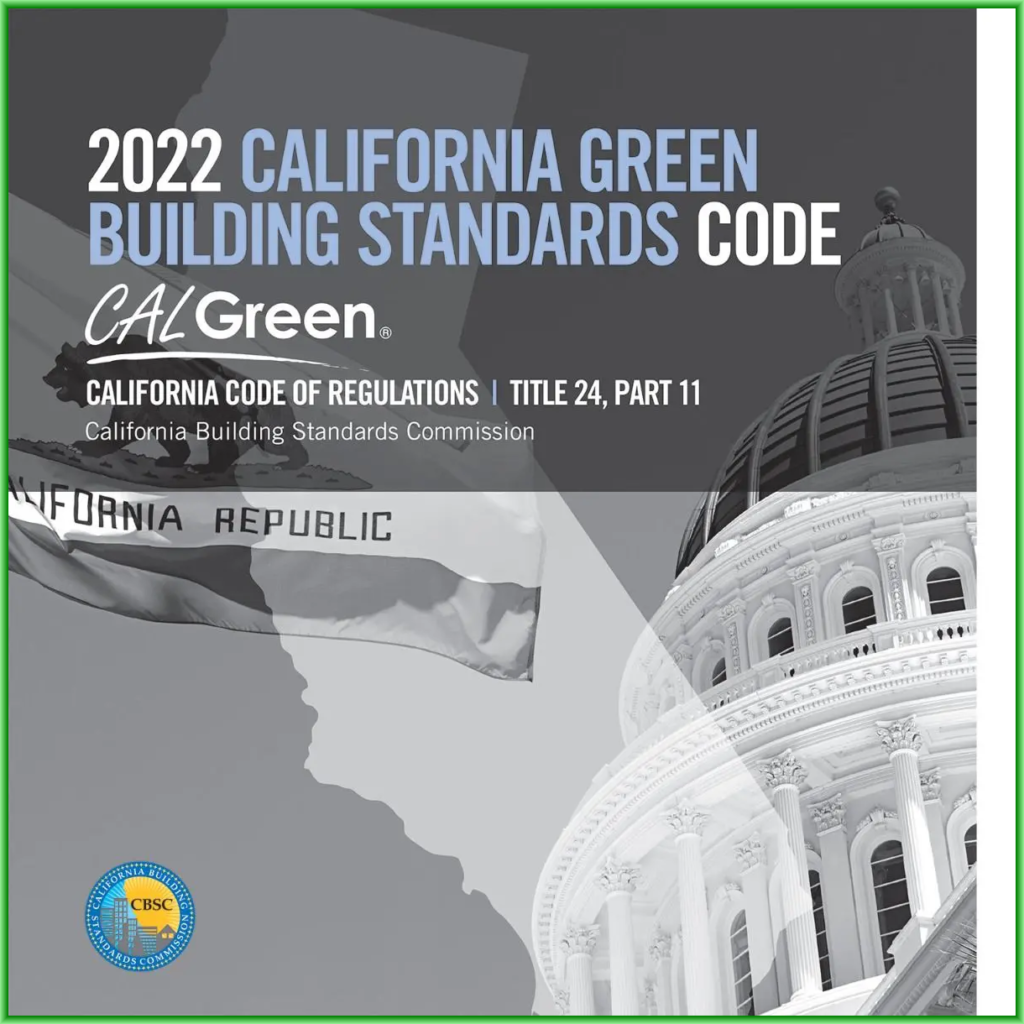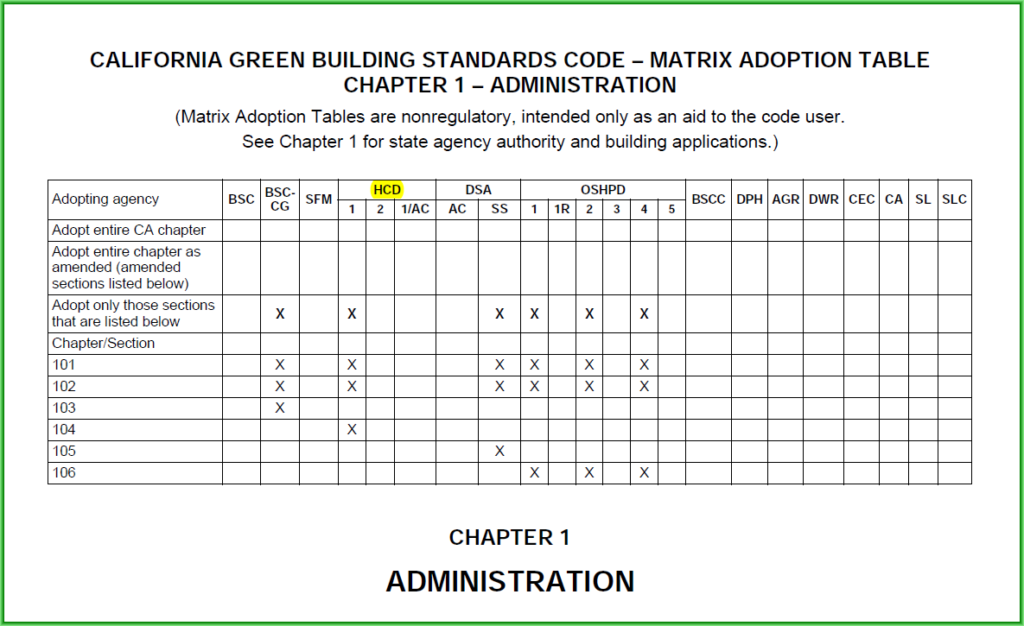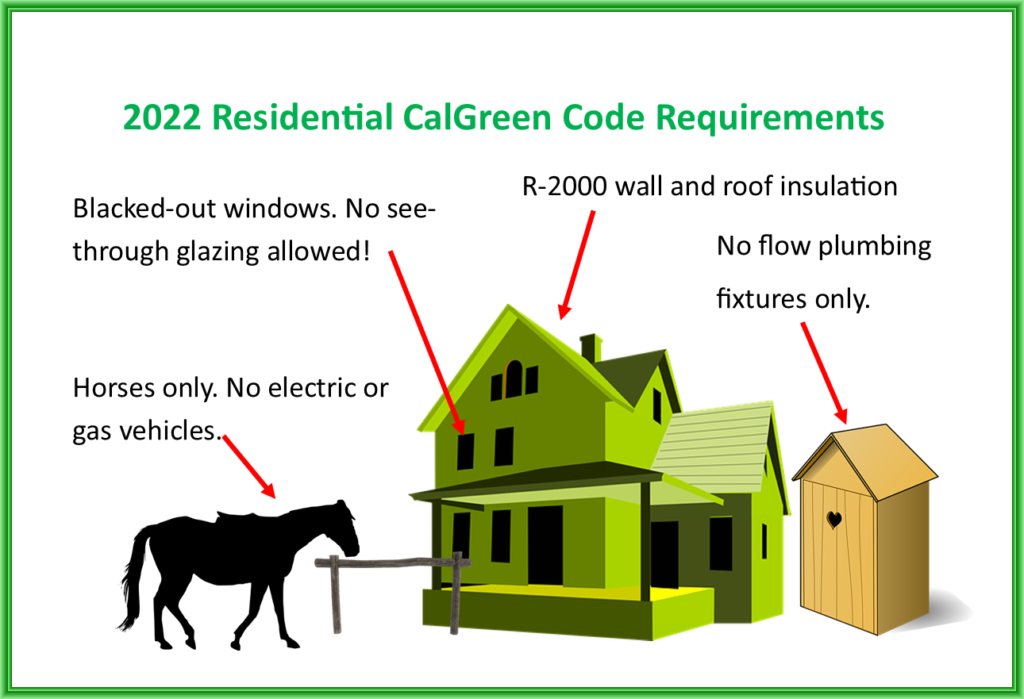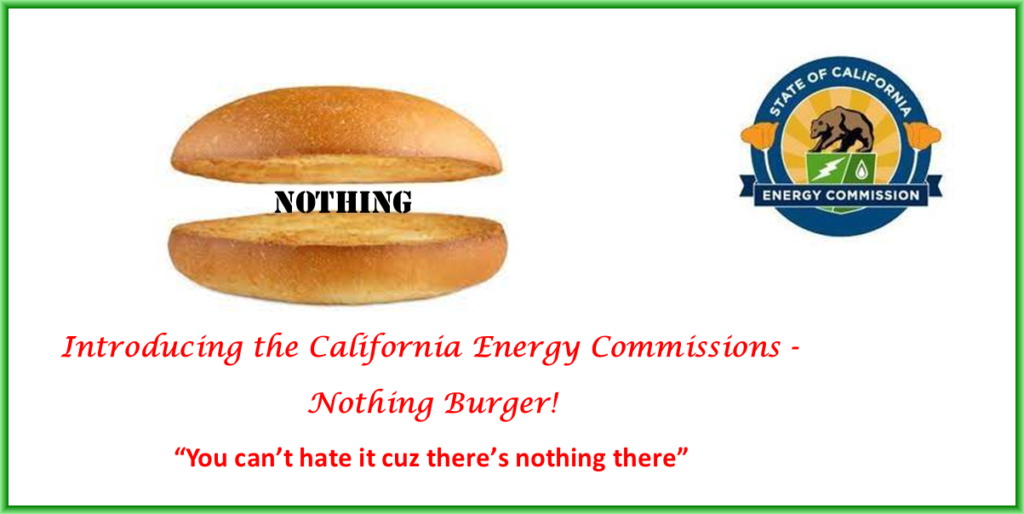2022 CalGreen Code Changes
2022 CalGreen Code Changes

This 2022 CalGreen Code changes summary will provide a detailed review of the new code changes. The changes will go into effect throughout California on January 1, 2023.
The California Green Building Standards Code contains standards applicable to residential and non-residential buildings throughout California, including schools and community colleges.
The California Green Building Standards Code, also known as “CALGreen”, goes through an update and approval process by the California Energy Commission (CEC) every three years. Once the CEC approves the changes they are submitted to the California Building Standards Commission for ratification into state law.
In addition the California Department of Housing and Community Development (HCD), also reviews and adopts the code for all residential buildings. HCD may not adopt some of the CalGreen Code changes. This can add some confusion when it comes to your CalGreen permit application. To determine whether a specific code section applies to your project, review the Matrix Adoption Table at the beginning of each chapter of the CalGreen Code. Here is the Chpater 1 Matrix Adoption Table from the 2022 code. You can see the HCD adoptions in column 4.
To further add to the confusion, your local jurisdiction may have added further changes to the requirements in your area. For this reason you should always check with your local building department.

The 2022 Changes
The following is a list of all the significant changes from the 2019 Green Building Standards Code to the 2022 CalGreen Building Standards Code. We have left out certain inconsequential changes that have no effect on the requirements.
Chapter 1 Administration
No regulatory changes
Chapter 2 Definitions
There were two new definition additions added regarding Electric Vehicle spaces and one explaining Level 2 EVSE equipment.
ELECTRIC VEHICLE (EV) CAPABLE SPACE. A vehicle space with electrical panel space and load capacity to support a branch circuit and necessary raceways, both underground and/or surface mounted, to support EV charging.
ELECTRIC VEHICLE (EV) READY SPACE. [HCD] A vehicle space which is provided with a branch circuit; any necessary raceways, both underground and/or surface mounted; to accommodate EV charging, terminating in a receptacle or a charger.
LEVEL 2 ELECTRIC VEHICLE SUPPLY EQUIPMENT (EVSE). [HCD] The 208/240-volt 40-ampere branch circuit, and the electric vehicle charging connectors, attachment plugs and all other fittings, devices, power outlets or apparatus installed specifically for the purpose of transferring energy between the premises wiring and the
electric vehicle.
They added new definitions for Zero-Emitting and High Efficiency Vehicles:
Zero emission vehicle (ZEV), enhanced advanced technology PZEV (enhanced AT ZEV) or transitional zero
emission vehicles (TZEV) regulated under CCR, Title 13, Section 1962.
High-efficiency vehicles, regulated by US EPA, bearing a fuel economy and greenhouse gas rating of 9 or 10 as regulated under 40 CFR Section 600 Subpart D.
There were a few other definitions added for clarification that does not affect the code requirements.

Chapter 3 Green Building
The new code contains requirements that apply to additions or alterations of existing parking facilities.
301.1 Existing Parking Facilities: The mandatory provisions of Section 4.106.4.2 may apply to additions or alterations of existing parking facilities or the addition of new parking facilities serving existing multifamily buildings. See Section 4.106.4.3 for application.
Chapter 4 Residential Mandatory Measures – Division 4.1 Planning and Design
4.106.4 Electric Vehicle Charging for New Construction: (The entire section has been changed significantly. The code now provides specific requirements for new multi-family dwellings with less than 20 dwelling units, and for those with more than 20 dwelling units. It requires future EVSE Level 2 Chargers and more. We will write a separate article on the new EV charge station requirements as the changes are too many to list here. Note that the requirements are still requiring provisions for future chargers, and not to install them at this time.)
Chapter 4 Residential Mandatory Measures – Division 4.2 Energy Efficiency
No changes
Chapter 4 Residential Mandatory Measures – Division 4.3 Water Efficiency and Conservation
No changes
Chapter 4 Residential Mandatory Measures – Division 4.4 Material Conservation and Resource Efficiency
Two new requirements added to the Operation and Maintenance Manual:
11. Information from the Department of Forestry and Fire Protection on maintenance of defensible space around
residential structures.
12. Information and/or drawings identifying the location of grab bar reinforcements.
Chapter 4 Residential Mandatory Measures – Division 4.5 Environmental Quality
No changes
Chapter 5 Non-Residential Mandatory Measures – Division 5.1 Planning and Design
5.106.5.3 (The entire section has been changed significantly. The previous separate requirements for single spaces requirements and multiple space requirements have been eliminated. The code now provides specific requirements for warehouses, grocery stores, and retail stores. Requires future EVSE Level 2 Chargers and more. We will write a separate article on the new EV charge station requirements as the changes are too many to list here.
5.106.12.1 Surface Parking Areas
An exception has been added for parking areas covered by photovoltaic systems:
Exceptions: Surface parking area covered by solar photovoltaic shade structures or shade structures with roofing materials that comply with Table A5.106.11.2.2 in Appendix A5 shall be permitted in whole or in part in lieu of shade tree plantings
5.106.12.2 Landscape Areas
An exception has been added for areas covered by photovoltaic systems, and designated play areas:
Exceptions:
1. Walks, hardscape areas covered by solar photovoltaic shade structures or shade structures with roofing materials that comply with Table A5.106.11.2.2 in Appendix A5 shall be permitted in whole or in part in lieu of shade tree plantings.
2. Designated and marked play areas of organized sport activity are not included in the total area calculation.
Chapter 5 Non-Residential Mandatory Measures – Division 5.2 Energy Efficiency
No changes.
Chapter 5 Non-Residential Mandatory Measures – Division 5.3 Water Efficiency and Conservation
No changes.
Chapter 5 Non-Residential Mandatory Measures – Division 5.4 Material Conservation and Resource Efficiency
No changes.
Chapter 5 Non-Residential Mandatory Measures – Division 5.5 Environmental Quality
A new section has been added with detailed requirements on CO2 monitoring and controls in classrooms (DSA-SS). Since this section only applies to schools regulated by DSA we have not copied the extensive list of items noted in paragraphs 1 through 6.. The following is the first paragraph of the new requirements.
5.506.3 Carbon dioxide (CO2) monitoring in classrooms. (DSA-SS) Each public K-12 school classroom, as listed in Table 120.1-A of the California Energy Code, shall be equipped with a carbon dioxide monitor or sensor that meets the following requirements: (See the code for additional requirements.)
Chapter 6 Reference Organizations and Standards
No changes.
Chapter 7 Installer and Special Inspector Qualifications
No changes.
Chapter 8 Compliance Forms, Worksheets, and Reference Materials
No changes
Residential Voluntary Measures
The following are the changes to the Voluntary Measures in the 2022 CalGreen Code.
Interesting Fact: These are NOT voluntary for your project if your local jurisdiction has adopted the Tier 1 or Tier 2 requirements. It’s mandatory!

Appendix A4 Residential Voluntary Measures – Division A4.1 Planning and Design
A significant change has been made to the EV Ready requirements for new multi-family development projects and hotels and motels. If your in a Tier 1 area (like Santa Rosa), they now require a whopping 35% of the total parking spaces be EV ready. This means that the electrical distribution system will have to be designed to handle this full load. Tier 2 locations will require 40% of parking spaces be EV ready (like Palo Alto).
A4.106.8.2 New multifamily development projects and hotels and motels. New multifamily development projects and hotels and motels shall meet the following requirements.
A4.106.8.2.1 Multifamily development projects and
hotels and motels.
Tier 1.
EV Ready. Thirty-five (35) percent of the total number of parking spaces shall be equipped with low power Level 2 EV charging receptacles. For multifamily parking facilities, no more than one receptacle is required per dwelling unit when more than one parking space is provided for use by a single dwelling unit.
See the code for the additional requirements in this section.
Appendix A4 Residential Voluntary Measures – Division A4.2 Energy Efficiency
The Energy Design Rating (EDR1) compliance margins have been significantly revised and no longer have separate requirements for mixed fuel versus all-electric. See Table A4.203.1.1 for details.
This voluntary measure sectio now requires two pre-requisite options. The 2019 code only required one:
A4.203.1.2 Prerequisite options. In addition, a minimum of TWO of the efficiency measures specified in Sections A4.2 will be required to be met.
The only other changes to this section are references to the California Energy Code.
Appendix A4 Residential Voluntary Measures – Division A4.3 Water Efficiency and Conservation
No changes.
Appendix A4 Residential Voluntary Measures – Division A4.4 Material Conservation and Resource Efficiency
No changes.
Appendix A4 Residential Voluntary Measures – Division A4.5 Environmental Quality
No changes.
Appendix A4 Residential Voluntary Measures – Division A4.6 Tier 1 and Tier 2
Minor references added to the California Energy Code. The CalGreen Checklist has been updated to reflect the revised EV charging requirements.
NonResidential Voluntary Measures

Appendix A5 Residential Voluntary Measures – Division A5.1 Planning and Design
The Tier 1 and Tier 2 Clean Air Vehicle parking requirements. The Tier 1 requirement has jumped from 10% to 35%. The Tier 2 requirement has jumped from 12% to 50%. (Does anyone else think this is just nuts?)
A5.106.5.1.1 Tier 1. Provide 35 percent designated parking spaces of the total number of parking spaces, for
any combination of zero-emitting, fuel-efficient and carpool/ van pool vehicles. Calculation for spaces shall be
rounded up to the nearest whole number.
A5.106.5.1.2 Tier 2. Provide 50 percent designated parking spaces of the total number of parking spaces, for
any combination of zero-emitting, fuel-efficient and carpool/van pool vehicles. Calculation for spaces shall be
rounded up to the nearest whole number.
The EV charging requirements have been completely revised.
A5.106.5.3 Electric vehicle charging (This entire section has changed and new terminology has been added. We will write a separate article on the new EV charge station requirements as the changes are too many to list here.)
Appendix A5 Residential Voluntary Measures – Division A5.2 Energy Efficiency
No changes.
Appendix A5 Residential Voluntary Measures – Division A5.3 Water Efficiency and Conservation
No changes.
Appendix A5 Residential Voluntary Measures – Division A5.4 Material Conservation and Resource Efficiency
No changes.
Appendix A5 Residential Voluntary Measures – Division A5.5 Environmental Quality
No changes.
Appendix A5 Residential Voluntary Measures – Division A5.6 Voluntary Tiers
The only change is the revised CalGreen Checklist that indicates the changes to the EV charging stations for both Tier 1 and Tier 2 requirements.
Appendix A6.1 Voluntary Standards for Health Facilities (OSHPD 1,2, & 4)
There were no changes to this section. This is not surprising since OSHPD does not follow the CalGreen voluntary measures. Instead, they are required to follow the PG&E Savings By Design program. Which begs the question – why does this section even exist?
Summary
As far as code changes go, these don’t move the needle very much. The changes to the electric vehicle charging station requirements are likely to cause some headaches for electrical engineers. Some commercial buildings could see a significant increase in their electrical service size if they get stuck with the 50% EV charging space requirements (Tier 2).
The changes in this code cycle highlight a fundamental problem with the CalGreen Code. The problem is that it is under the control of the California Energy Commission (CEC). The CEC’s primary concern is energy efficiency, and we can see that in these code changes. What we do not see is a single improvement in sustainable design! In three years of investigating improvements to California’s sustainable design, they come up with – absolutely nothing.

This code cycle reveals a real problem with California’s sustainable future. The problem is that energy efficiency goals are frequently at odds with sustainability goals. A wise old engineer I once worked with was in a meeting with a well-known city discussing their new Library. The issue of energy efficiency and LEED compliance came up.
“Well,” says the wise old grey-hair, “I can give you an energy efficient building, or I can give you a LEED building, but I can’t do both.”
There is some truth to that statement. Although I hate the idea of more government, I believe that California’s sustainable code should be taken out from under the control of the California Energy Commission and put under the control of a department dedicated to sustainable design. To leave California’s sustainable design future under the CEC’s control will virtually guarantee no advancements in sustainability.
Sustainable design in California is more important than ever. The fact that the CEC failed to move the needle, at all, is a clear indication that this should be taken out of their hands. It should be under control of an organization that understands and promotes sustainable design.
At CalGreen Energy Services we are specialists in the CalGreen Code. CalGreen is our only business. If you have a CalGreen question please feel free to give us a call. We are happy to share our knowledge.
Call us today and let us show you how we can help with your project.
Gary Welch
Email: gary@calgreenenergyservices.com
Phone: 707-328-5299


Gary Welch has over 35 years experience in the field of sustainable building design. He is the CEO of CalGreen Energy Services. Gary is an ICC Certified CalGreen Special Inspector and Plans Examiner.

